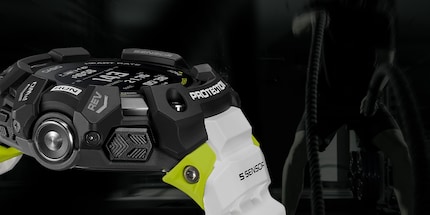
G-Shock launches smartwatch with solar cells
Casio's rugged label G-Shock is releasing a smartwatch. With five sensors and solar cells, it is designed to compete with other smartwatches.
Watch manufacturer Casio has made a name for itself with its G-Shock label for bringing robust watches with a strong design onto the market. The watches are neither subtle nor discreetly coloured, but according to the manufacturer they are virtually indestructible. Until now, the manufacturer has been satisfied with watches that have only displayed a few other data in addition to the time. With the G-Shock G-Squad GBD-H1000, the full name of the watch, G-Shock is launching its first smartwatch on the market.
Special feature: the watch charges itself with built-in solar cells.
The watch that charges itself
With eight hours under fluorescent light, the GBD-H1000 charges itself enough to power the time display and pedometer functions. Sports functions such as GPS or heart rate measurement require more energy and therefore drain the battery more. The solar cells in Casio's watch cannot keep up.
Solar cells in watches are one of the biggest innovations of the current smartwatch year. As a smartwatch cannot exceed a certain size - the human wrist is generally somewhat small - and a battery cannot be smaller than a certain size, the battery is one of the major sticking points in the construction of a smartwatch. Where you used to have to charge your smartwatch every day or every other day, manufacturers such as Garmin have managed to achieve battery life of ten days in training mode. That's not enough, because traditional watches only need a new battery once a year and then run indefinitely again. The smartwatch industry therefore relies on solar cells that recharge the battery beforehand.
Casio outlines the conditions under which their solar cells perform optimally quite precisely on the website:
When charged about eight hours every day under indoor fluorescent lighting (500 lux), and charged at window side on a sunny day for two hours in a week (10,000 lux).
Data analysis from the Garmin analyst
The range of functions of the G-Shock GBD-H1000 and its design suggest that the manufacturer designed the watch as a tool. Among other things, it has an optical heart rate sensor, a GPS system and a compass, a speedometer, a thermometer and a barometer. The data analysis is provided by the manufacturer Firstbeat. Firstbeat is the company behind Garmin's data analysis tools.

What is missing is the touchscreen on the hardware side. However, the design suggests large buttons, as a G-Shock is not known for its delicate design and compactness. On the software side, it is not yet known to what extent smart notifications and associated networks will be supported. A screenshot shows an email and the text underneath promises social network service (SNS) notifications.

According to the unofficial G-Shock fansite G-Central, the G-Show GBD-H1000 will be available in Asia from 24 April. The date of a possible launch in Europe is not yet known. Or whether it will come to Europe at all.
Journalist. Author. Hacker. A storyteller searching for boundaries, secrets and taboos – putting the world to paper. Not because I can but because I can’t not.